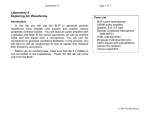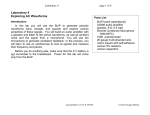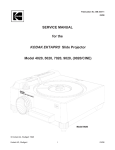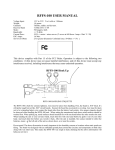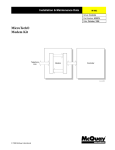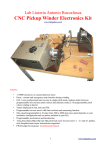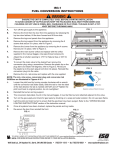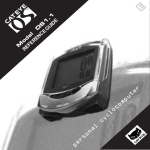Download Lab 2
Transcript
Laboratory 2 Laboratory 2 More Resistor Networks and Potentiometers. Introduction page 1 of 5 Parts List 100K potentiometer single-strand 22 gauge wire various 5% resistors 9 V battery battery clip BLIP board and parts (without chips) This is a relatively short laboratory, because while some of you are doing it, others of you will be using one of the soldering irons in the lab to put together your BLIP (Breadboard Laboratory Interface Processor). The BLIP was designed and programmed by former Pitt Bioengineering undergraduate, David Weiser, and you each will own one. You will learn how to use it in subsequent laboratories, but for now your job is just to construct your very own BLIP by soldering the parts onto its printed circuit board (PCB). Procure your BLIP baggie with the little PCB and all the parts from your TA. (A) Download or view online the BLIP User Manual from the course schedule for Lab 1. The Parts List for the BLIP is in Section 2.2.1 of the BLIP User Manual. Make sure all the parts listed are in the baggie, except for the chips, which we will hand out later. Follow the instructions in the BLIP User Manual to solder the parts to the board and have your TA inspect the board. Take care and enough time to do a good job with soldering your BLIP, as repairing it later is never as satisfactory. (B) You will not actually be inserting the chips and testing the BLIP until a later laboratory. If you find that all the soldering irons (we only have five or six) are occupied, proceed to the rest of the lab, in which you will build some more resistor networks, learn about the variable resistor (potentiometer) and make some interesting measurements and calculations. Come back to finish your blip when the soldering irons are free (perhaps even some other time during the week). 1/16/13 © 2013 George Stetten Laboratory 2 page 2 of 5 The Variable Resistor (Potentiometer) The potentiometer (or simply “pot”) is an essential component in many electronic circuits, because it provides the ability to adjust voltages and currents by changing the location of a “wiper” on a special resistor. The pot you will use contains a semicircular 100K resistor (below left) with a “single turn” wiper that is swept from one end to the other, by turning the little screw over a range of about 300 degrees, as shown in the diagram (below center). The schematic for the pot (below right) indicates the value of the underlying fixed resistor and the direction of motion effected by turning the screw clockwise (CW). Turning the screw clockwise (CW) moves the wiper towards the 3 pin end of the resistor. 2 1 3 1 2 3 1/16/13 © 2013 George Stetten Laboratory 2 page 3 of 5 The pot is shown below inserted into the breadboard so that each pin occupies a different column. The pins, numbered as before, 1, 2 and 3, are shown here resectively (in this case) in breadboard columns 22, 23, and 24. Purple leads are shown coming from the ends of the resistor (pins 1 and 2) and a green lead is shown coming from the wiper (pin 2). The central screw is seen pointing at about about the “2 o’clock” position. Turning the screw clockwise (CW) moves the wiper towards the 3 pin end of the resistor. Using your ohmeter, measure the total resistance across the resistor in the pot, between pins 1 and 3. (C) Then, attach your ohmeter between leads 1 and 2 and turn the pot. Record the behavior of this resistance as a function of the direction and the extent of rotation. Repeat for the resistance between pins 2 and 3. (D) 2 1 3 Set the pot at about 2 o’clock as shown in the picture. Record the resistance between pins 1 and 2 as well as the resistance between pins 2 and 3. Does their sum approximately equal the total resistance between pins 1 and 3? (E) 1/16/13 © 2013 George Stetten Laboratory 2 page 4 of 5 Using a Pot as a Voltage Divider, and the Effect of a Load One of the most common uses of a pot is to deliver some fraction of a given voltage. As shown in the schematic below, the wiper in effect divides the pot into two resistors whose ratio can be adjusted, providing any desired voltage between the battery voltage VB (should be a little more than 9 V) and zero volts (ground). Note that the schematic does not show the connections between the various grounds in the circuit, although you should provide those connections by using one of the (-) horizontal busses on your breadboard. Build the circuit, attaching your voltmeter (on the 20 V full scale setting) as shown, and record the behavior of the output voltage as you turn the screw on the pot, as a function of the direction and extent of rotation. (F) Adjust the output voltage Vout to exactly 5 volts. Then measure VB and compute the values of the “two resistors” on either side of the wiper. Without changing the setting of the pot, disconnect the battery and measure these resistances directly (between pins 1 and 2, and pins 2 and 3, respectively). Compare the measured resistances to those you computed. Why did you disconnect the battery to make these measurements? (G) Without changing the setting of the pot, reconnect the battery and the voltmeter to recreate the circuit below. Then put a 10K “load” resistor (not shown) across the output (between pin 2 of the pot and ground) and record the new output voltage Vout. Draw the circuit including the 10 K resistor and derive an equation that yields the new output voltage, as a function of VB and the two resistances you computed above. (H) + - 1/16/13 © 2013 George Stetten Laboratory 2 page 5 of 5 The Wheatstone Bridge The Wheatstone Bridge is an accurate way to measure an unknown resistance by comparing the voltages between two voltage dividers. By using a potentiometer as one of the voltage dividers, it is possible to “zero out the voltage” so that the ratio of the dividers match each other. The circuit below is an example of a Wheatstone bridge. Our goal is to compute the “unknown” value of R2 (which in this case we actually know to be 62 K). Note that “R3” and “R4” represent the resistances in the pot on either side of the wiper for a particular setting. Derive an equation for R2 in terms of R1, R3, and R4. (I) Why is the battery voltage VB not part your equation? (J) Use the voltmeter adjust the pot so that the meter reads exactly 0 V (you can use the most sensitive voltage setting, 200 mV full scale to do this). Then, without changing the setting of the pot, dismantle the circuit and measure R1, R3 and R4 directly using the ohmmeter, and compute R2. Then measure R2 directly and compare to your calculated value. (K) What advantage in terms of accurately determining R2 with the Wheatstone bridge can you see, in not having the battery voltage VB as part of the calculation? (L) 1/16/13 © 2013 George Stetten





